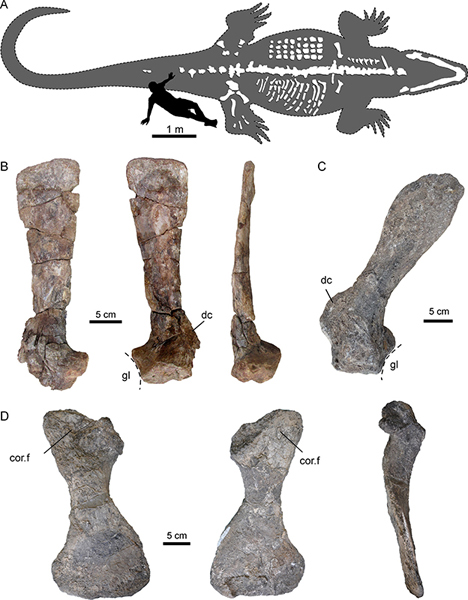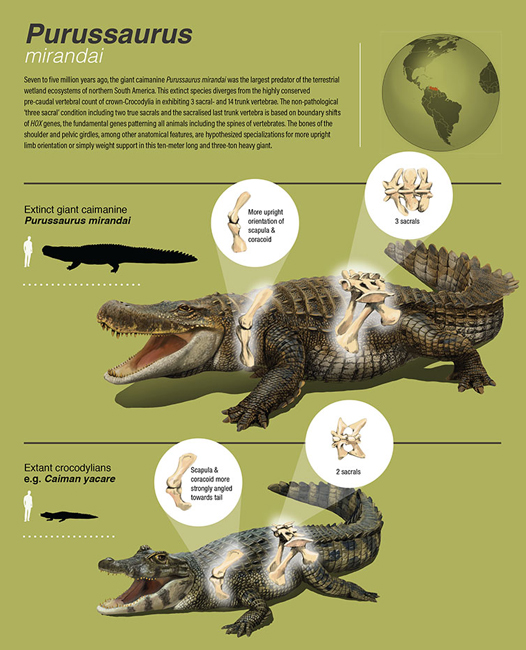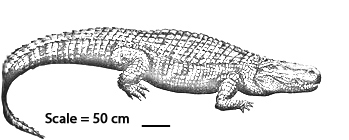Purussaurus mirandai – Had an Extra Vertebra to Assist Movement
The giant, prehistoric caiman Purussaurus mirandai, known from Miocene-aged deposits of Venezuela, had unique anatomical adaptations to help it move. New research, published in the on-line journal “eLife” by an international team of scientists led by Dr Torsten Scheyer of the Palaeontological Institute and Museum of Zurich, demonstrate that this three-tonne predator was able to support its huge bulk by having an extra vertebra in its hip region (sacrum) and the shoulder girdle had also become specially adapted to assist terrestrial movement.
Comparing the Anatomy of P. mirandai to an Extant Caiman (C. Yacare)
Picture credit: JA Chirinos/The Royal Veterinary College
A Swamp Dweller But Capable of Moving Around on Land
The unusual characteristics suggest that although Purussaurus would have been very much at home in rivers and swamps it was also able to move around on land, although not all that quickly, but over rough terrain and a short distance, this 8-metre-long reptile could have threatened to catch a typical member of our own species . This research links nicely into a study carried out on the locomotion of modern crocodilians undertaken recently by the Royal Veterinary College, a study that Everything Dinosaur intends to report upon in the near future.
It is the only crocodilian to date to have an extra vertebra in its sacrum. Purussaurus had three sacral vertebrae not the usual two. This development requires changes to the “Hox genes” that control where certain body parts are formed. The scientists noticed that some living crocodilians suffer malformations that cause an extra vertebra to be created in their sacrum, so it is evident that the Hox genes that can make these evolutionary changes remain available to crocodilians today.
Purussaurus mirandai
Commenting on the findings, co-author of the study, Professor John Hutchinson (Royal Veterinary College) stated:
“We didn’t think that Purussaurus moved quickly on land. Our findings are important because they help show how development can be altered in order to enable biomechanical changes as animals evolve into larger body sizes.”
Selected Forelimb Bones of Purussaurus from the Urumaco Formation of Venezuela

Picture credit: The Royal Veterinary College
Fossils from Venezuela
Lead author of the research, Dr Torsten Scheyer commented:
“We have been extremely lucky to find such a high amount of fossils in the badlands of Venezuela, which allowed the recognition of the unique condition in the hip region of the giant Purussaurus in the first place. These old bones show us once again that the morphological variation seen in animals that are long extinct extends well beyond that of what is known in living animals, and thereby broadens our knowledge of what animals can do in evolution.”
An Illustration of the Fearsome Crocodilian Purussaurus mirandai
Picture credit: Everything Dinosaur
The scientific paper: “Giant extinct caiman breaks constraint on the axial skeleton of extant crocodylians” by Torsten M Scheyer, John R Hutchinson, Olivier Strauss, Massimo Delfino, Jorge D Carrillo-Briceño, Rodolfo Sánchez and Marcelo R Sánchez-Villagra published in eLife.
View the Everything Dinosaur website: Everything Dinosaur.








Leave A Comment